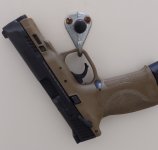Ok first off I'm a 50+ year shooter, carrier, user of 1911s so hang with me. I'm not talking about whether a striker fired pistol should have a thumb safety or not-I'm quite ok without one.
What I'd like to know is why is the thumb safety on the Shield/Plus so tiny?! I can disengage it fairly easily but not when I try to engage it while holding it in a typical manner. I have to rotate the gun out of my firing grip, hold it on it's side and push up with the end of my thumb to engage it.
I'd like to put the standard single thumb safety the "larger" pistols use but don't think that's possible. Right now I carry it without the safety engaged-and I'm quite comfortable doing so fyi-and only engage it when the pistol is off my body/out of the holster.
This Shield Plus is the only M&P I have with the thumb safety-and posted about doing so without paying attention LOL.
Does anyone know if the single side safety will work on the Shield Plus? Since it's there I'd like to have a slightly extended thumb safety on it similar to my various 1911s.
What I'd like to know is why is the thumb safety on the Shield/Plus so tiny?! I can disengage it fairly easily but not when I try to engage it while holding it in a typical manner. I have to rotate the gun out of my firing grip, hold it on it's side and push up with the end of my thumb to engage it.
I'd like to put the standard single thumb safety the "larger" pistols use but don't think that's possible. Right now I carry it without the safety engaged-and I'm quite comfortable doing so fyi-and only engage it when the pistol is off my body/out of the holster.
This Shield Plus is the only M&P I have with the thumb safety-and posted about doing so without paying attention LOL.
Does anyone know if the single side safety will work on the Shield Plus? Since it's there I'd like to have a slightly extended thumb safety on it similar to my various 1911s.

